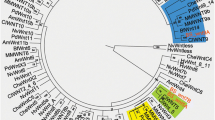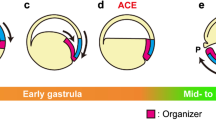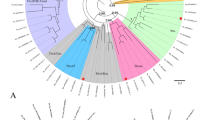Summary
In the polysteelid ascidian,Polyandrocarpa misakiensis, buds can arise at any antero-posterior positional level around the basal margin of a functional zooid. In this study, each bud was cut into anterior and posterior halves along its proximo-distal axis. When an anterior half was combined with a posterior half from a higher (more posterior) level, the future zooid developed the same anteroposterior polarity as a normal bud. When the same operation was performed with a posterior half from a lower (more anterior) level, the antero-posterior polarity was inverted, resulting in a reversed body asymmetry (situs inversus viscerum). Bud polarity depended not on the size or the growth stage of the fragmented buds, but on the difference in parental positional levels from which respective buds to be fused had originated. Surgically constructed doublehalf buds developed a single polarity instead of a pattern reduplication. Insertion experiments with bud pieces showed that the gap between the positional levels was recognized at the proximal region of operated buds. The results of this study are inconsistent with the predictions of the polar coordinate model for pattern formation. It is concluded that a parent zooid possesses antero-posterior position-specific potential for determining bud polarity.
Similar content being viewed by others
References
Abbott DP (1953) Asexual reproduction in the colonial ascidianMetandrocarpa taylori Huntsman. Univ Calif Publ Zool 61:1–78
Berking S (1979) Analysis of head and foot formation inHydra by means of an endogenous inhibitor. Wilhelm Roux's Archives 186:189–210
Berrill NJ (1940) The development of a colonial organism:Symplegma viride. Biol Bull 79:272–281
Berrill NJ (1941a) The development of the bud inBotryllus. Biol Bull 80:169–184
Berrill NJ (1941b) Size and morphogenesis in the bud ofBotryllus. Biol Bull 80:185–193
Bryant SV, French V, Bryant PJ (1981) Distal regeneration and symmetry. Science 212:993–1002
Cameron J, Fallon JF (1977) Evidence for polarizing zone in the limb buds ofXenopus laevis. Develop Biol 55:320–330
Fallon JF, Crosby GM (1977) Polarizing zone activity in limb buds of amniotes. In: Ede DA, Hinchliffe JR, Balls M (eds) Vertebrate limb and somite morphogenesis. Cambridge University Press, Cambridge, pp 55–69
French V, Bryant PJ, Bryant SV (1976) Pattern regulation in epimorphic fields. Science 193:969–981
Holder N, Tank PW, Bryant SV (1980) Regeneration of symmetrical forelimbs in the axolotl,Ambystoma mexicanum. Develop Biol. 74:302–314
Honig LS (1981) Positional signal transmission in the developing chick limb Nature 291:72–73
Iten LE, Bryant SV (1975) The interaction between the blastema and stump in the establishment of the anterior-posterior and proximal-distal organization of the limb regenerate. Develop Biol 44:119–147
Iten LE, Murphy DJ (1980) Pattern regulation in the embryonic chick limb: Supernumerary limb formation with anterior (non-ZPA) limb bud tissue. Develop Biol. 75:373–385
Izzard CS (1973) Development of polarity and bilateral asymment in the palleal bud ofBotryllus schlosseri (Pallas). J Morph 139:1–26
Javois LS, Iten LE (1981) Position of origin of donor posterior chick wing bud tissue transplanted to an antierior host site determines the extra structures formed. Develop Biol 82:329–342
Kawamura K, Watanabe H (1982a) Localized morphogenetic activity in the palleal bud of a polystyelid ascidian,Polyandrocarpa disakiensis. I. A histological study. Mem Fac Kochi Univ Ser D 3:55–69
Kawamura K, Watanabe H (1982b) Pattern development in palleal buds of botryllid ascidians: Relation between parent and its buds in their body axes. J Morph 173:293–304
Kawamura K, Watanabe H (1982c) Pattern development in palleal buds of the polystyelid ascidian,Polyandrocarpa misakiensis. Bud grafting induces bilateral asymmetry conversion through polarity reversal. J Exp Zool (in press)
MacCabe JA, Parker BW (1976) Polarizing activity in the developing limb of the Syrian hamster. J Exp Zool 195:311–317
MacWilliams HK (1982) Pattern formation inHydra head regeneration. Am Zool 22:17–26
Oda T, Watanabe H (1982) Induction of malformed zooids and determination of polarity in palleal buds of the polystyelid ascdian,Polyandrocarpa misakiensis. J Exp Zool 220:21–31
Sabbadin A (1955) Osservazioni sullo sviluppo, l'accrecimento la riproduzione diBotryllus schlosseri (Pallas), in condizioni di laboratorio. Boll Zool 22:243–263
Sabbadin A (1958) Analisi sperimentale dello sviluppo delle colonie diBotryllus schlosseri (Pallas). Arch Ital Anat Embriol 63:178–221
Sabbadin A, Zaniolo G, Majone F (1975) Determination of polarity and bilateral asymmetry in palleal and vascular buds of the ascidianBotryllus schlosseri. Develop Biol 46:79–87
Saunders JW, Gasseling MT (1968) Ectodermal-mesenchymal interactions in the origin of limb. In: Fleischmajer, R, Billingham, R. (eds) Epithelial-mesenchymal interactions. Williams & Williams, Baltimore, Md. pp 78–97
Schaller HC, Schmidt T, Grimmerlikhuijzen CJP (1979) Separtion and specificity of action of four morphogens from hydra. Wilhelm Roux's Arch 186:139–149
Slack MW (1977) Control of antero-posterior pattern in the axolotl forelimb by a smoothly graded signal. J Embryol exp Morph 39:169–182
Stocum DL (1975) Outgrowth and pattern formation during limb ontogeny and regeneration. Differentiation 3:167–182
Sugimoto K, Nakauchi M (1974) Budding, sexual reproduction, and degeneration in the colonial ascidian,Symplegma reptans. Biol Bull 147:213–226
Summerbell D (1979) The zone of polarizing activity: evidence for a role in normal chick limb morphogenesis. J Embryol exp Morph 50:217–233
Summerbell D, Tickle C (1977) Pattern formation along the antero-posterior axis of the chick limb bud. In: Ede DA, Hinchliffe JR, Balls M (eds) Vertebrate limb and somite morphogenesis. Cambridge University Press, Cambridge, pp 55–69
Tickle C, Summerbell D, Wolpert L (1975) Positional signalling and specification of digits in chick limb morphogenesis. Nature 254:199–202
Tickle C, Shellswell G, Crawley A, Wolpert L (1976) Positional signalling by mouse limb polarizing region in the chick wing bud. Nature 259:396–397
Watanabe H, Tokioka T (1972) Two new species and one possibly new race of social styelids from Sagami Bay, with remarks on their life history, especially the mode of budding. Publ Seto Mar Biol Lab 14:327–345
Wilby OK, Webster G (1970) Experimental studies on axial polarity in hydra. J Embryol Exp Morph 24:595–613
Wolpert L (1969) Positional information and the spacial pattern of cellular differentiation. J Theor Biol 25:1–47
Author information
Authors and Affiliations
Rights and permissions
About this article
Cite this article
Kawamura, K., Watanabe, H. The role of parental positional information in the determination of antero-posterior polarity during palleal budding in ascidians. Wilhelm Roux' Archiv 192, 28–36 (1983). https://doi.org/10.1007/BF00848766
Received:
Accepted:
Issue Date:
DOI: https://doi.org/10.1007/BF00848766




